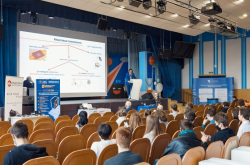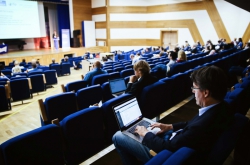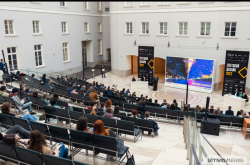Traditionally, the conference is hosted by ITMO University and is organized with support from the Optical Society of America (OSA), Society of Photo-optical Instrumentation Engineers (SPIE) and Institute of Electrical and Electronics Engineers (IEEE).Students and scientists discussed the relevant topics of such fields as physical optics and spectroscopy, laser physics and technology, photonics systems and devices, IT in photonics, biotechnical systems, etc. Every day, the conference’s participants could attend up to 30 different presentations, as well as acquaint themselves with their colleagues’ works at the poster session featuring more than a hundred participants.
Representatives of nine Russian and international companies took part in the Industrial Photonics session. The organizer company, IC Specpostavka is a major distributor of electronic components, measurement equipment, power supplies, and embedded systems. The company’s representative Nikita Bugrov stressed that though their enterprise largely works with the world’s leading electronics and optics manufacturers, it now aims to develop collaboration with domestic partners. What’s more, Specpostavka can act as a mediator and help Russian companies establish contacts with potential foreign clients.

Korbinian Hens, engineer for the HUBNER GmbH & Co company (Germany), presented laser light sources for continuous-wave emission that tune themselves automatically. The greatest advantage of such systems is that one doesn’t have to adjust the equipment, just give it a command via a computer. The technology was named C-WAVE; it allows to tune the wavelength in both visible and IR band without the need to adjust the equipment’s optical components. The system can have many applications in spectroscopy, metrology, atomic and quantum physics, as well as holography: according to Korbinian Hens, such laser sources can create unique holograms for protecting important documents. Such holograms are very hard to copy, as they are created by combining different types of wavelengths. What is more, the tunable solid-body C-WAVE is a great alternative to organic-dye lasers.
 Korbinian Hens
Korbinian Hens
Francois Richou from IDQuantique SA (Switzerland) spoke about photon detectors, true random number generators and other of his company’s equipment used in the relevant field of quantum communications. Photon detectors are used to register extremely weak signals. As of today, highly sensitive avalanche mode photodiodes with fast response time are used in such devices. The issue here is that after detecting a photon, the system has a paralysis period; also, the detector can be rendered insensible in the presence of considerable background luminance. Yet, as the photon detection time can be calculated, one can use a controlled impulse, so the detector can be active at a particular time. The Swiss company develops different methods for decreasing the noise levels in photon detection, as well as adjustable photon detecting devices customized per their customers’ needs.
 Francois Richou
Francois Richou
Single-photon detectors are widely applied in quantum communication and cryptography technologies where detecting weak light pulses is essential. Also, single photon detection is important in space communication technologies and metrology. In natural sciences, such sensors are used for measuring miniscule particles via dynamic light scattering methods, measuring the fluorescence lifetime, and many other purposes.
Artur Gleim, CEO of the Quantum Communications company, expanded on the current technologies and products of the quantum communications market in more detail. The company is a small innovations enterprise created at ITMO University that deals in quantum cryptography information protection technologies. Quantum cryptography is a data encryption method which is impossible to penetrate, as such an attempt would destroy the information carriers - single photons. One can read more about this technology in another article by ITMO.NEWS.
 Artur Gleim
Artur Gleim
According to Artur Gleim, the current quantum communications market has already reached 1 billion USD, even though quantum communications is a relatively new field. Quantum communications are especially popular in Asia, and many companies look for new applications of this novelty. Thus, companies need new testing sites, i.e. working quantum communications channels, where they can trial-run new inventions. In Russia, there are several such channels; for instance, one unites two of ITMO University’s buildings. Another quantum network uniting four different locations exists in Kazan.
“Many of the devices we use in our everyday lives - traffic lights, mobile phones - make use of different data encryption methods. Gradually, we learn to adjust quantum cryptography for such applications, and integrate common users into the new protected data channels,” comments Artur Gleim.

Other representatives of companies that manufacture modern optical and photonic devices and equipment also made their presentations at the Industrial Photonics session. Menlo Systems GmbH (Germany) that develops measuring devices for both industrial and laboratory use presented its recent inventions; Russian Inversia-Sensor company presented its latest projects in the field of fiber optic control systems. Amongst the participants also were the Fedal company that develops and manufactures laser electronics and electronic components for optical devices, Polaris company that produces picosecond fiber lasers, and Avesta-Project that deals in different kinds of femtosecond lasers, measuring equipment and optical mechanics.





